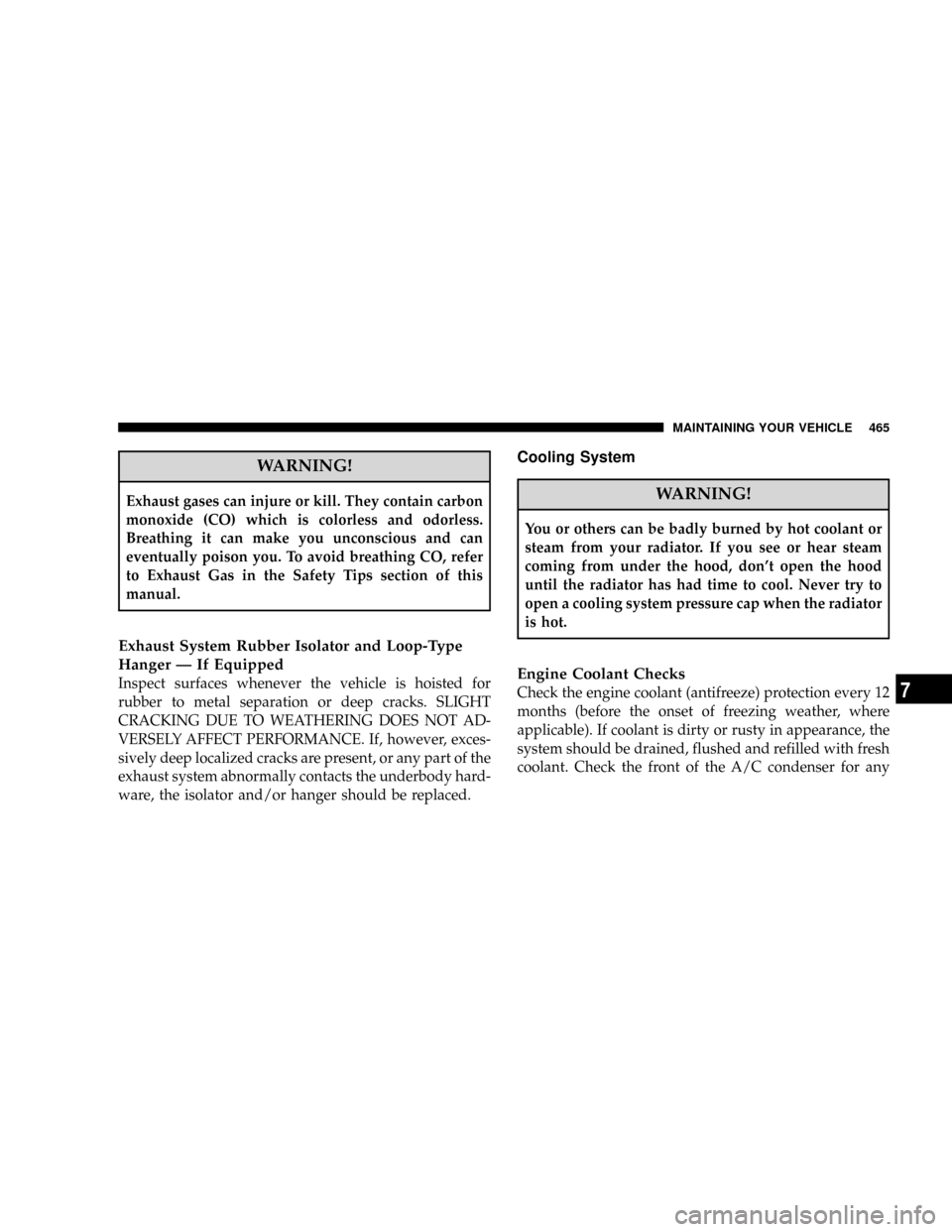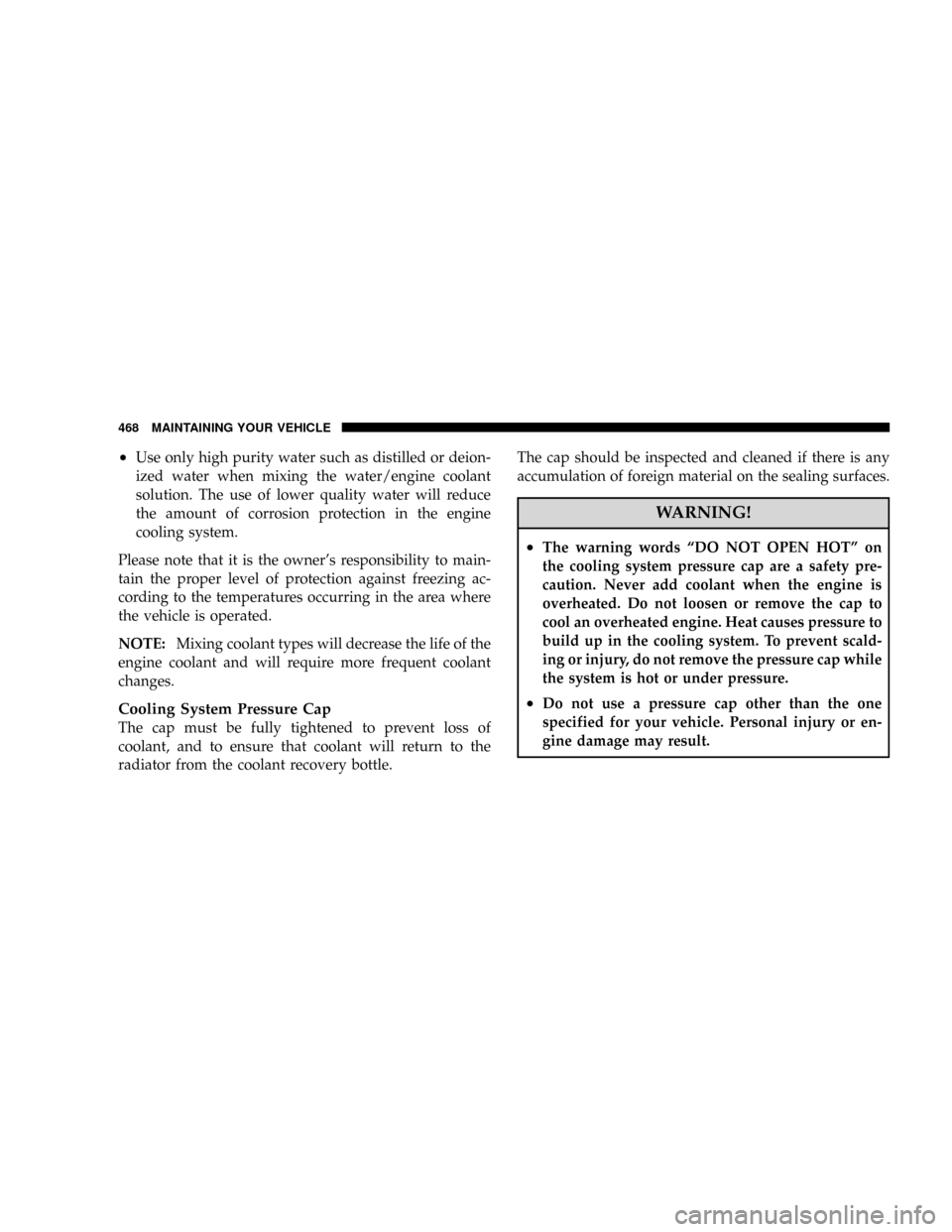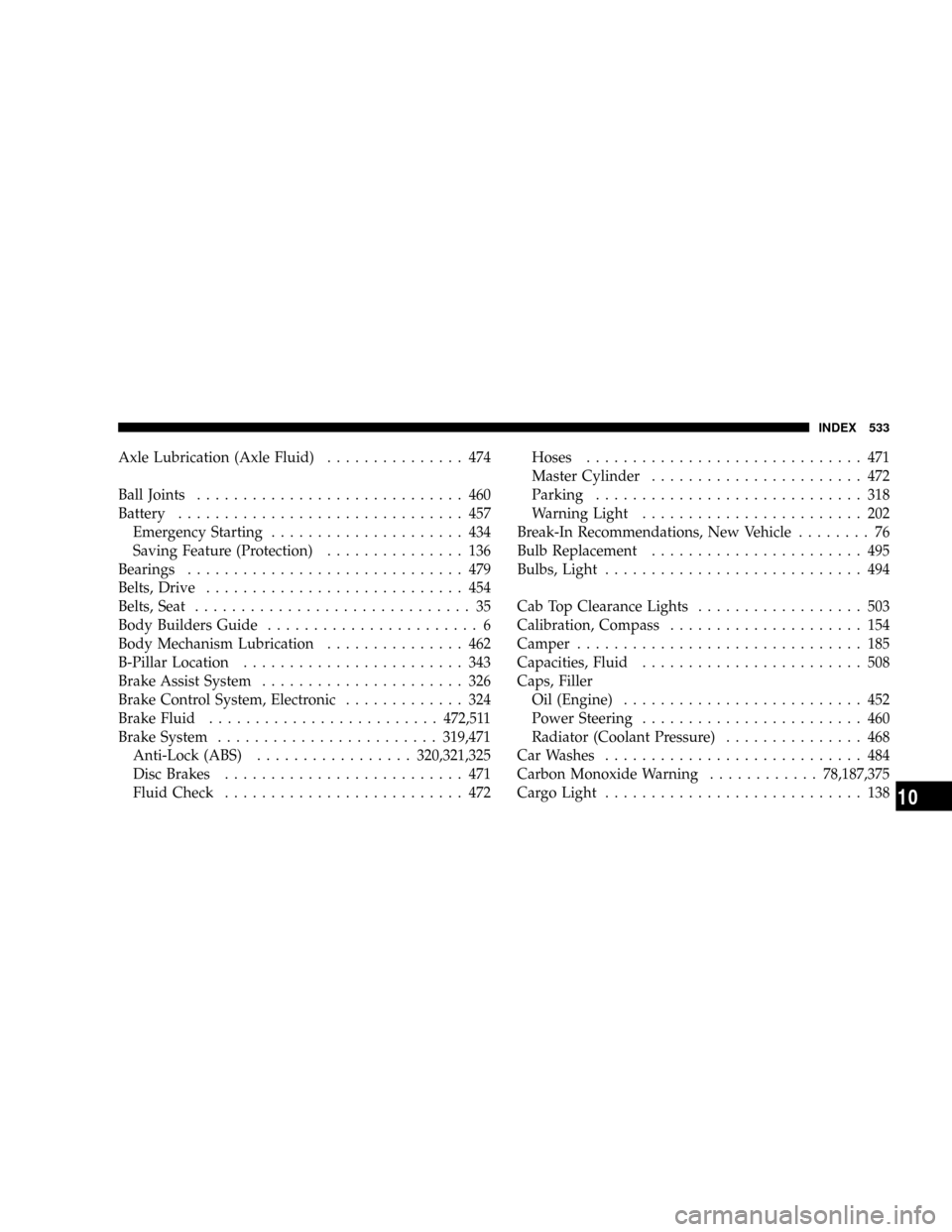2008 DODGE RAM 3500 GAS radiator cap
[x] Cancel search: radiator capPage 467 of 554

WARNING!
Exhaust gases can injure or kill. They contain carbon
monoxide (CO) which is colorless and odorless.
Breathing it can make you unconscious and can
eventually poison you. To avoid breathing CO, refer
to Exhaust Gas in the Safety Tips section of this
manual.
Exhaust System Rubber Isolator and Loop-Type
Hanger Ð If Equipped
Inspect surfaces whenever the vehicle is hoisted for
rubber to metal separation or deep cracks. SLIGHT
CRACKING DUE TO WEATHERING DOES NOT AD-
VERSELY AFFECT PERFORMANCE. If, however, exces-
sively deep localized cracks are present, or any part of the
exhaust system abnormally contacts the underbody hard-
ware, the isolator and/or hanger should be replaced.
Cooling System
WARNING!
You or others can be badly burned by hot coolant or
steam from your radiator. If you see or hear steam
coming from under the hood, don't open the hood
until the radiator has had time to cool. Never try to
open a cooling system pressure cap when the radiator
is hot.
Engine Coolant Checks
Check the engine coolant (antifreeze) protection every 12
months (before the onset of freezing weather, where
applicable). If coolant is dirty or rusty in appearance, the
system should be drained, flushed and refilled with fresh
coolant. Check the front of the A/C condenser for any
MAINTAINING YOUR VEHICLE 465
7
Page 468 of 554

accumulation of bugs, leaves, etc. If dirty, clean by gently
spraying water from a garden hose vertically down the
face of the condenser.
Check the coolant recovery bottle tubing for brittle rub-
ber, cracking, tears, cuts and tightness of the connection
at the bottle and radiator. Inspect the entire system for
leaks.
With the engine at normal operating temperature (but
not running), check the cooling system pressure cap for
proper vacuum sealing by draining a small amount of
coolant from the radiator drain cock. If the cap is sealing
properly, the engine coolant (antifreeze) will begin to
drain from the coolant recovery bottle. DO NOT RE-
MOVE THE COOLANT PRESSURE CAP WHEN THE
COOLING SYSTEM IS HOT.Cooling System Ð Drain, Flush and Refill
At the intervals shown on the Maintenance Schedules,
the system should be drained, flushed and refilled.
If the solution is dirty or contains a considerable amount
of sediment, clean and flush with a reliable cooling
system cleaner. Follow with a thorough rinsing to remove
all deposits and chemicals. Properly dispose of old
antifreeze solution.
Selection Of Coolant
Use only the manufacturer's recommended coolant; for
correct coolant type, refer to ªEngine Coolantº under
ªFluids, Lubricants and Genuine Partsº in this section.
466 MAINTAINING YOUR VEHICLE
Page 470 of 554

²Use only high purity water such as distilled or deion-
ized water when mixing the water/engine coolant
solution. The use of lower quality water will reduce
the amount of corrosion protection in the engine
cooling system.
Please note that it is the owner's responsibility to main-
tain the proper level of protection against freezing ac-
cording to the temperatures occurring in the area where
the vehicle is operated.
NOTE:Mixing coolant types will decrease the life of the
engine coolant and will require more frequent coolant
changes.
Cooling System Pressure Cap
The cap must be fully tightened to prevent loss of
coolant, and to ensure that coolant will return to the
radiator from the coolant recovery bottle.The cap should be inspected and cleaned if there is any
accumulation of foreign material on the sealing surfaces.
WARNING!
²The warning words ªDO NOT OPEN HOTº on
the cooling system pressure cap are a safety pre-
caution. Never add coolant when the engine is
overheated. Do not loosen or remove the cap to
cool an overheated engine. Heat causes pressure to
build up in the cooling system. To prevent scald-
ing or injury, do not remove the pressure cap while
the system is hot or under pressure.
²Do not use a pressure cap other than the one
specified for your vehicle. Personal injury or en-
gine damage may result.
468 MAINTAINING YOUR VEHICLE
Page 471 of 554

Disposal of Used Engine Coolant
Used ethylene glycol-based engine coolant is a regulated
substance requiring proper disposal. Check with your
local authorities to determine the disposal rules for your
community. To prevent ingestion by animals or children
do not store ethylene glycol-based engine coolant in open
containers or allow it to remain in puddles on the
ground. If ingested by a child, contact a physician
immediately. Clean up any ground spills immediately.
Coolant Level
The coolant bottle provides a quick visual method for
determining that the coolant level is adequate. With the
engine cold, the level of the coolant in the coolant
recovery bottle should be between the ranges indicated
on the bottle.
The radiator normally remains completely full, so there is
no need to remove the radiator cap unless checking for
coolant freeze point or replacing coolant. Advise yourservice attendant of this. As long as the engine operating
temperature is satisfactory, the coolant bottle need only
be checked once a month.
When additional coolant is needed to maintain the
proper level, it should be added to the coolant bottle. Do
not overfill.
Points To Remember
NOTE:When the vehicle is stopped after a few miles (a
few kilometers) of operation, you may observe vapor
coming from the front of the engine compartment. This is
normally a result of moisture from rain, snow, or high
humidity accumulating on the radiator and being vapor-
ized when the thermostat opens, allowing hot coolant to
enter the radiator.
If an examination of your engine compartment shows no
evidence of radiator or hose leaks, the vehicle may be
safely driven. The vapor will soon dissipate.
MAINTAINING YOUR VEHICLE 469
7
Page 535 of 554

Axle Lubrication (Axle Fluid)............... 474
Ball Joints............................. 460
Battery............................... 457
Emergency Starting..................... 434
Saving Feature (Protection)............... 136
Bearings.............................. 479
Belts, Drive............................ 454
Belts, Seat.............................. 35
Body Builders Guide....................... 6
Body Mechanism Lubrication............... 462
B-Pillar Location........................ 343
Brake Assist System...................... 326
Brake Control System, Electronic............. 324
Brake Fluid.........................472,511
Brake System........................319,471
Anti-Lock (ABS).................320,321,325
Disc Brakes.......................... 471
Fluid Check.......................... 472Hoses.............................. 471
Master Cylinder....................... 472
Parking............................. 318
Warning Light........................ 202
Break-In Recommendations, New Vehicle........ 76
Bulb Replacement....................... 495
Bulbs, Light............................ 494
Cab Top Clearance Lights.................. 503
Calibration, Compass..................... 154
Camper............................... 185
Capacities, Fluid........................ 508
Caps, Filler
Oil (Engine).......................... 452
Power Steering........................ 460
Radiator (Coolant Pressure)............... 468
Car Washes............................ 484
Carbon Monoxide Warning............78,187,375
Cargo Light............................ 138
INDEX 533
10
Page 536 of 554

Cassette Tape and Player Maintenance......... 257
Catalytic Converter...................... 455
CD (Compact Disc) Player............ 211,219,233
Cellular Phone.......................... 91
Center High Mounted Stop Light............ 502
Center Lap Belts......................... 45
Center Seat Storage Compartment.........173,174
Certification Label....................... 381
Chart, Tire Sizing........................ 340
Check Engine Light
(Malfunction Indicator Light)............... 201
Child Restraint........................62,63
Child Restraint Tether Anchors.............66,71
Child Seat............................63,70
Cigar Lighter........................... 168
Cleaning
Wheels............................. 486
Climate Control......................... 259
Clock.....................209,213,221,234,248Clutch............................... 474
Clutch Linkage Maintenance................ 474
Compact Disc (CD) Maintenance............. 258
Compact Spare Tire...................... 351
Compass...........................153,154
Compass Calibration..................... 154
Compass Variance....................... 155
Computer, Trip/Travel.................... 149
Console, Overhead....................... 148
Contract, Service........................ 525
Coolant Pressure Cap (Radiator Cap).......... 468
Cooling System......................... 465
Adding Coolant (Antifreeze).............. 467
Coolant Capacity...................... 508
Coolant Level......................465,469
Disposal of Used Coolant................ 469
Drain, Flush, and Refill.................. 466
Inspection........................... 469
Points to Remember.................... 469
534 INDEX
Page 537 of 554

Pressure Cap......................... 468
Radiator Cap......................... 468
Selection of Coolant (Antifreeze)......466,508,510
Temperature Gauge..................... 198
Cruise Control (Speed Control).............. 145
Cupholders............................ 169
Customer Assistance..................... 523
Data Recorder, Event...................... 60
Daytime Running Lights................... 137
Dealer Service.......................... 450
Defroster, Rear Window.................89,182
Defroster, Windshield................79,260,263
Delay (Intermittent) Wipers................. 141
Differential, Limited-Slip.................. 313
Dipsticks
Automatic Transmission................. 477
Power Steering........................ 460
Disc Brakes............................ 471Disposal
Antifreeze (Engine Coolant)............... 469
Door Locks............................. 27
Door Opener, Garage..................... 156
Drive Belts............................ 454
Drive Shaft Universal Joints................ 461
Driving
Through Flowing, Rising, or Shallow Standing
Water................................ 315
Dual Rear Wheels.....................361,431
DVD Player (Video Entertainment SystemŸ).... 251
E-85 Fuel............................. 377
Electric Rear Window Defrost.............89,182
Electrical Power Outlets................... 166
Electronic Brake Control System............. 324
Anti-Lock Brake System................. 325
Brake Assist System.................... 326
Electronic Roll Mitigation................ 332
INDEX 535
10
Page 545 of 554

Opener, Garage Door (HomeLinkt) ........... 156
Operating Precautions.................... 447
Outside Rearview Mirrors.................. 87
Overdrive............................. 285
Overdrive OFF Switch.................... 285
Overhead Console....................148,149
Overhead Travel Information Center.......... 149
Owner's Manual (Operator Manual).......... 527
Parking Brake.......................... 318
Passenger Airbag On/Off Switch............. 56
Passing Light........................... 140
Pedals, Adjustable....................... 144
Pets.................................. 76
Pets, Transporting........................ 76
Phone, Cellular.......................... 91
Phone, Hands-Free (UConnectt) .............. 91
Pickup Box............................ 183
Placard, Tire and Loading Information......... 344Positive Crankcase Valve.................. 457
Power
Distribution Center (Fuses)............... 489
Door Locks........................... 28
Mirrors.............................. 88
Outlet (Auxiliary Electrical Outlet).......... 166
Seats............................122,124
Sliding Rear Window................... 182
Steering..........................323,460
Sunroof............................. 163
Windows............................. 32
Power Steering Fluid..................... 511
Pregnant Women and Seat Belts.............. 47
Pretensioners
Seat Belts............................. 45
Radial Ply Tires......................... 351
Radiator Cap (Coolant Pressure Cap).......466,468
Radio Broadcast Signals................... 209
INDEX 543
10